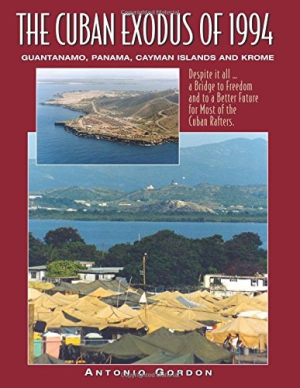The Cuban Exodus of 1994
Guantanamo, Panama, Cayman Islands and Krome
This is a work that honors the strength and resourcefulness of Cuban refugees who risked everything in their quests for freedom.
Antonio Gordon’s comprehensive The Cuban Exodus of 1994 details how many Cubans, desperate over the hardships and tyranny of Castro-style communism, fled to find freedom. Gordon enlists extensive primary and secondary sources to illustrate the experiences of the refugees.
The book covers a range of topics: the causes of the Cuban exodus, relevant policies enacted by Cuban and American leaders, the role of the American military and relief agencies involved in the crisis, and the Cuban exile community in Florida. Its focus throughout is most on the Cuban people, and it details their suffering under the communist dictatorship as well as their desperate, heroic attempts to “[throw] themselves into the sea in search for freedom” and what their lives were like in the detention camps set up for rescued refugees. Because Guantanamo housed most of the refugees for the duration of the crisis, life in other camps—in Panama, the Cayman Islands, and Krome, near Miami—is given less attention.
The work shows that the living conditions in Cuba, always tenuous since Castro’s 1959 revolution, reached a critical stage after the dissolution of the Soviet Union, which ended many years of subsidies from Russia. That moment led to the “insecurity and public disorder” that prompted a rash of escape attempts in homemade rafts by more than fifty thousand Cubans in late 1994. The rafters were “like rocks … from an apparently endless quarry,” Gordon writes.
The plights of the rafters, or balseros, are illustrated by many well-placed testimonials from those who survived the ordeal. A letter from a detainee tells of a man at Guantanamo who left Havana on a raft with his twenty-nine-year-old son and a friend. After a week at sea, his dehydrated son dove into the water and never reappeared. Later, the man’s friend died on the raft, and the lone survivor was forced to throw the body overboard before he was eventually rescued. More than ten thousand rafters of all ages died at sea.
While Gordon evokes much sympathy for the refugees’ suffering, the bulk of his book is a tribute to their resilience, patience, and resourcefulness. He tells of the nearly intolerable conditions as the camps soon became overcrowded and of the blow to detainee morale from US Attorney General Janet Reno’s announcement that America would not grant citizenship to the rafters.
Eventually the American military at Guantanamo gained the resources to accommodate the thirty-two thousand refugees who were rescued and detained there. Soon, clean water, mail service, and a field hospital eased the tension. Thereafter, the Cuban presence at Guantanamo featured a library, a chapel, schools, parks, an art museum, and recreational facilities. Cubans were building furniture, tending gardens, and having babies.
An amazing amount of primary and secondary research supports Gordon’s overview of camp conditions and culture. His personal memorabilia and his collection of articles, photos, cartoons, and letters from camp newspapers is supplemented by articles from American newspapers and studies published by other researchers.
The work was first published in Spanish in 2015; Antonio Gordon intends for this English edition of The Cuban Exodus of 1994 to reach the many Americans, military and civilian, who aided the rafters in their quest for freedom.
Reviewed by
Joe Taylor
Disclosure: This article is not an endorsement, but a review. The publisher of this book provided free copies of the book and paid a small fee to have their book reviewed by a professional reviewer. Foreword Reviews and Clarion Reviews make no guarantee that the publisher will receive a positive review. Foreword Magazine, Inc. is disclosing this in accordance with the Federal Trade Commission’s 16 CFR, Part 255.

